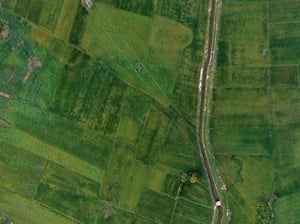Amidst increasing demand for land in the UK, farmers and land managers are being advised to tap into cutting-edge ‘location science’ and geospatial data to help them make the right business choices.
Pressure for farmers to adapt and consider diversification
A recent report from the UK Government’s Geospatial Commission highlighted that agriculture is the sector facing the greatest threat of essential changes in UK land use1.
According to the report, the agriculture sector is the most dominant ‘land taker’ in England, occupying almost two thirds of total land area.
It says the sector is under pressure to meet the food and energy needs of a growing population, adapt to climate change and protect nature – as well as adjust to radical changes in public funding as the Rural Payments Agency (RPA)’s Basic Payment Scheme (BPS) is gradually phased out.
In the meantime, the launch of Defra’s Sustainable Farming Incentive (SFI) presents new income opportunities for farm and estate businesses.
Read our advice on how farmers and land managers can make the most of SFI funding options here.
How natural capital science and data can help land managers understand business opportunities
To find a balance, farmers must embrace opportunities to ‘multipurpose’ land using science and data, says Paul Brown, Senior Geographic Information (GI) Remote Sensing Specialist at Fera.
“As the Geospatial Commission’s research shows, high quality geospatial data is incredibly valuable when it comes to investigating where agricultural land could potentially be used in a smarter way and exploring business opportunities,” he explains.
However, 56% of farmers and land managers who took part in our online poll said they weren’t confident that they know what ‘natural capital data’ means and what it looks like on their farm or estate.
“Without understanding the detail of what assets you currently have, you won’t know which income opportunities are most attractive or suitable for your farm or estate business,” says Paul.
Mapping and monitoring farmland natural capital, habitats and environmental projects
Fera’s team of LAND360 scientists work with geospatial data to map how rural land is currently being used and investigate where different management options could deliver maximum reward for both the environment and a land-based business.
“We carry out geospatial mapping at a regional level, right through to mapping unique individual habitats at a farm, or even field, scale,” says Paul.
“We can then build a baseline with this mapping data, which allows farmers to understand the impact of investing in sustainability projects, such as sowing a wildflower meadow or herbal ley, and pinpoint which farm locations are best-suited for this.”
Understanding farmland data
Farmland sustainability projects don’t necessarily have to replace existing farming practices, they could work alongside them – for example, an agroforestry strip within a cereal field.
“Understanding farmland data also gives a steer on which government schemes, such as the Sustainable Farming Incentive, and/or private finance schemes could be applied to make these environmental projects financially viable,” says Paul.
“We know that farmers and land managers are under pressure to keep businesses profitable through huge funding changes; capturing, monitoring and understanding farmland data is a vital first step to making more informed business decisions, and visualising the long-term impact of sustainability initiatives.”
Read how sustainable land management can help to futureproof farm businesses here.
Expert support to access and interpret land data
Our LAND360 service helps to make geospatial data more accessible and useable for farmers.
“Fera can help at every step, visualising land use change and modelling different option scenarios so that you can understand which schemes or blend of schemes – government or private – would be best to undertake,” adds Paul.
To find out more about Fera and what the LAND360 services team can do visit: https://www.fera.co.uk/land360-land-management
Reference
- Department for Science, Innovation and Technology, Geospatial Commission (2023) Finding common ground: Integrating data, science and innovation for better use of land: https://www.gov.uk/government/publications/finding-common-ground-integrating-data-science-and-innovation-for-better-use-of-land/finding-common-ground-integrating-data-science-and-innovation-for-better-use-of-land#section-2-demands-on-land